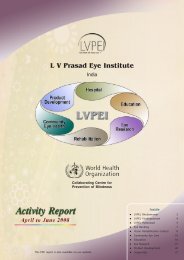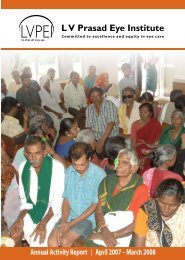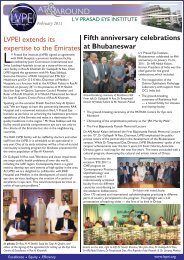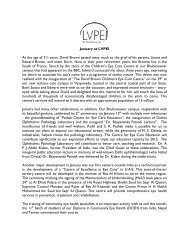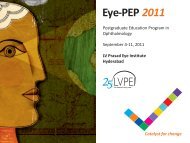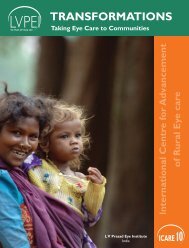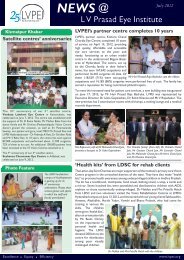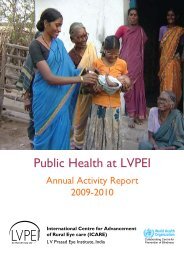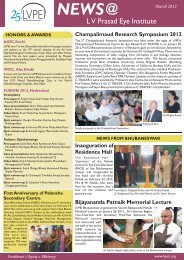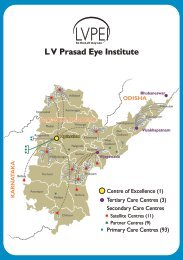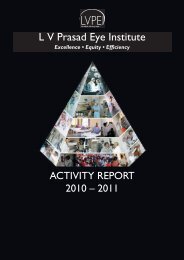Glimpses 2009-2010.pdf - LV Prasad Eye Institute
Glimpses 2009-2010.pdf - LV Prasad Eye Institute
Glimpses 2009-2010.pdf - LV Prasad Eye Institute
You also want an ePaper? Increase the reach of your titles
YUMPU automatically turns print PDFs into web optimized ePapers that Google loves.
Genetic testing for retinoblastoma:<br />
Retinoblastoma is a cancer of the eye that affects infants and<br />
young children, usually below the age of 5 years. It can be<br />
treated more effectively and the child’s eye as well as his/her<br />
life can be saved if detected in the early stages. The formation<br />
of retinoblastoma is triggered by an alteration of a gene known<br />
by the same name (RB1 in short), and a parent who has such an<br />
altered (mutated) copy of the RB1 gene can pass on the gene<br />
to the children who are consequently at risk of developing the<br />
tumor. Our research team, including Vidya Parsam from the<br />
Kallam Anji Reddy Molecular Genetics Laboratory, Dr Santosh<br />
Honavar and Dr Md Javed Ali from the Ocular Oncology<br />
Service, and Dr Geeta K Vemuganti from the Ophthalmic<br />
Pathology Service are looking at ways of identifying mutations<br />
in the RB1 gene among patients with retinoblastoma. This would reveal the underlying cause for the<br />
disease, so that if a mutation is found in a patient, his or her relatives can be screened to see who is<br />
at risk of developing the tumor.<br />
Using a combination of techniques in the molecular genetics laboratory, we developed an effective<br />
procedure for detecting RB1 mutations and have been able to successfully identify the underlying<br />
mutations in over 80% of patients we tested. The tests were also designed in a way that would reduce<br />
the costs of chemicals involved. Apart from designing an effective screening test for predicting those<br />
at risk for developing retinoblastoma, we also have interesting observations on the kinds of genetic<br />
alterations in RB1 that are responsible for this form of cancer. By using different approaches, we have<br />
found novel and unexpected alterations in the gene. Vidya Parsam, the research fellow on this team,<br />
got recognition for this work — a Young Scientist award from the K V Rao Scientific Society and a<br />
travel fellowship to attend the annual meeting of the ARVO in May 2010, to present a paper. This test<br />
can be set up for routinely screening families who desire to be tested. If a child is at risk by virtue of<br />
having the defective gene, he/she needs to undergo frequent examination to detect the tumor early,<br />
while those who do not carry it need not be subjected to frequent examinations.<br />
Chitra Kannabiran<br />
Kallam Anji Reddy Molecular Genetics Laboratory<br />
A low cost method for field based diagnostics – the LAMP assay<br />
Molecular diagnostics, especially<br />
Polymerase Chain Reaction (PCR) is widely<br />
used for the rapid diagnosis of infectious<br />
diseases. PCR uses precision equipment<br />
including a thermal cycler, electrophoretic<br />
apparatus and a gel documentation system<br />
to detect the presence of pathogen DNA.<br />
The expense and expertise associated with<br />
such equipment is a major obstacle to its<br />
widespread use in secondary and primary<br />
health care settings. Recently, scientists<br />
at the Prof Brien Holden <strong>Eye</strong> Research<br />
Centre developed a cost effective Loop<br />
mediated isothermal Amplification assay<br />
(LAMP assay) for the rapid detection of<br />
Excellence Equity Efficiency Page<br />
36<br />
F_Inside_Pgs.indd 36<br />
9/2/2010 12:33:07 PM



